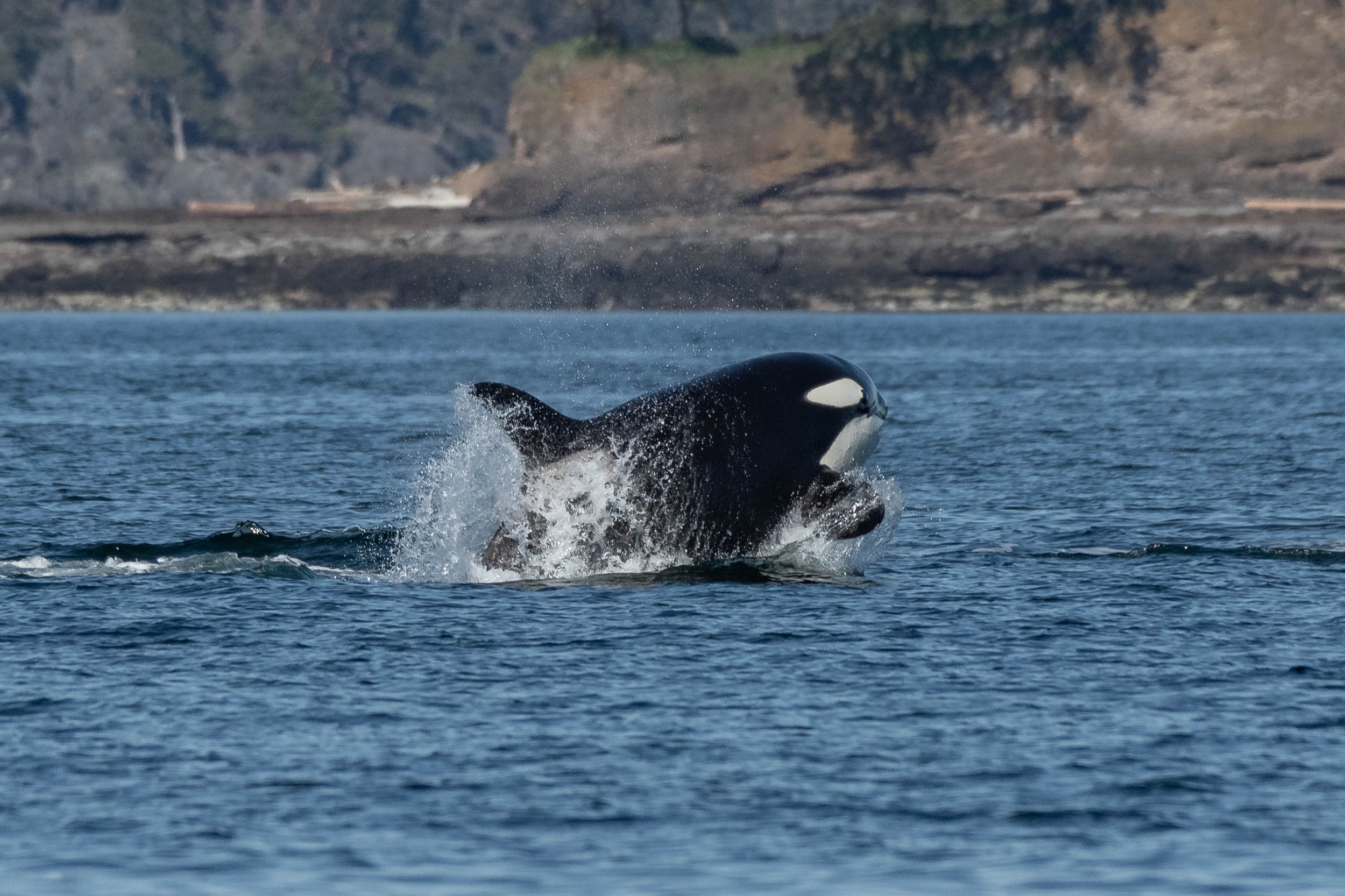May 1, 2025, 12:00 PM - Patience pays off!!
Some days, we really have to work for it—and today was one of those days! We set sail at our usual departure time, full of hope but knowing the challenge ahead. Our earlier tour had come up empty-handed, so we knew we had to cover serious ground. We zigged and zagged—south, north, east, and finally west. Over 200 kilometres and more than three hours later, our perseverance finally paid off. Way up north, off the island of Lasqueti, we found them—a group of orca cruising through the open water. After such a long search, the moment felt even more magical. **And wow—**it was worth the wait!
We had ourselves a T-Party! The Orca present at the party were:
T124A2 Elkugu ♀ (2001)
T124A2A Agafia ♂ (2013)
T124A2B Litton ♀ (2016)
T071B Hood ♀ (2000)
T071B1 Zengo ♀ (2013)
T071B2 Tasli/Nemo ♂ (2018)
T086A Eider ♀ (1988)
T086A4 Akia ♀ (2016)
T086A5 (2024)
T065 Whidbey II ♀ (~1971)
T063 Chainsaw ♂ (~1978)
T087 Harbeson ♂ (~1962)
T065B Chunk ♀ (1993)
T065B1 Birdsall ♂ (2011)
T065B2 Nettle ♂ (2019)
T065B3 (2023)
What is a T-Party? Why do orca come together in these situations?
All of our transient/Bigg’s orca have scientific identification numbers that begin with a “T,” so naturally, we like to call their gatherings “T-Parties” when multiple matrilines come together. Think of it as a big family-and-friends reunion! These meetups happen from time to time for a few key reasons:
Social Bonding
Orca are incredibly social and tactile animals, enjoying both companionship and physical contact. We often observe them swimming right on top of each other—because they actually are! Unlike resident orca, transients travel in much smaller pods, so they often form temporary alliances with relatives or familiar individuals. These strong bonds can play a crucial role in successful future hunts. Even though transient orca are apex predators, grouping up offers safety in numbers. It can help deter competition from other orca or large sharks and is useful when facing aggressive prey.
Cooperative Hunting
Transient orca are mammal hunters, with seals, sea lions, porpoises, dolphins, and even large baleen whales on the menu. When hunting smaller prey, they coordinate attacks and block escape routes. For something larger, like a Minke whale, teamwork is essential. This is where those temporary alliances come into play. By taking turns resting, chasing, and attacking, orca can wear down even large, powerful prey, dramatically increasing their chances of success.
Learning and Teaching
Young orca learn by watching experienced adults. These group gatherings allow for knowledge-sharing and the passing down of specialized hunting techniques. For example, we've witnessed one of our large males swimming on his side to hide his dorsal fin while approaching sea lions on log booms—a clever strategy!
Reproduction
Males and females from different family groups may associate temporarily to mate, helping to prevent inbreeding. We have good reason to believe that might have been happening at this T-Party!
Resource Availability
When prey is abundant, such as during a dolphin migration or when seals haul out in large numbers, multiple families may gather in one area to take advantage of the feast.
After enjoying our invite to the T-Party, we headed off to meet some of the orcas’ more formidable prey: the Steller sea lions! These massive animals are the largest sea lions in the world. Mature males can reach lengths of 11 feet and weigh up to 2,800 pounds. Even for top predators like orca, hunting one is no easy task. Steller sea lions have powerful jaws, large teeth, and even some sharp claws in the mix. We watched them bicker and jostle over the best sunning spots on the rocks—classic sea lion behaviour! Warming up is essential after diving into those chilly depths to hunt fish. With all that action, it was finally time to head home. Good things definitely came to those who waited today!
Enjoy the photos below taken by Marine Naturalist Aly Kohlman.
Steller Sea Lions sunning on the rocks.
A Steller pose!
Two colourful male Harlequin ducks and one female following behind.
Some very fuzzy Steller Sea Lions.
A little itchy.
Have you ever scene an orca T071B1 Zengo chased by a sea snake? P.S. this is the reason we guessed mating may be occuring.
T065B1 Birdsall facing the camera with T086A Eider (left) and T071B Hood (right).
Left to right: T124A2 Elkugu, T086A4 Akia and T065 Whidbey ll.
Breach!
T086A Eider and her 2024 calf T086A5.
T063 Chainsaw!
A good look at T063 Chainsaw’s eye patch.
Another sea snake makes an appearance.
Taking a peek above the waves.
T063 Chainsaw making a splash!
He’s having fun in the sun!
T086A Eider with her missing bottom teeth.
A great look at the pectoral fin.
Full speed ahead!
Still going strong!
Tail slapping good time.
T124A2A Agafia with his distinct fluke.
T065B1 Birdsall.
T063 Chainsaw.
A tail lob!
T071B2 Tasli/Nemo’s upturned tail.
T063 our camera hog, Chainsaw!
T086A5 following mom.
Getting frisky!
T065B Chunk going dow
Tails up!
T087 old man Harbeson.
































